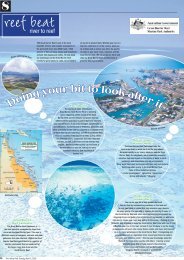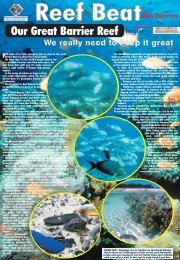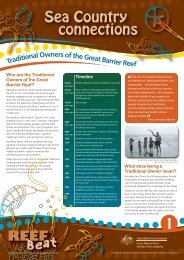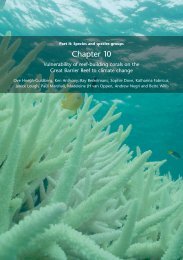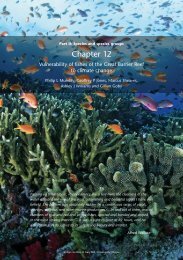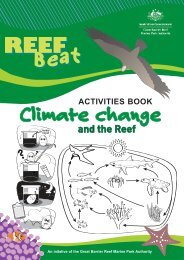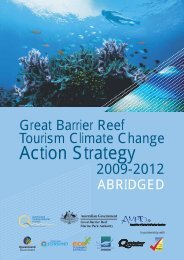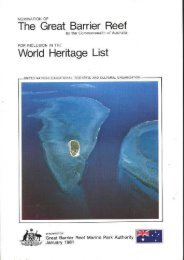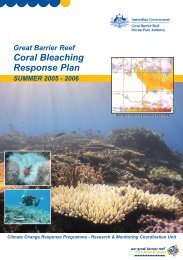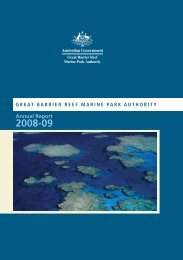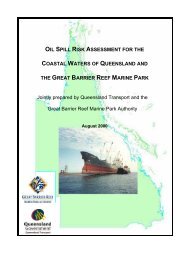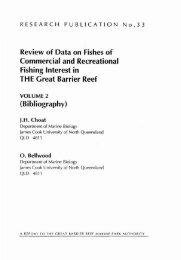Great Barrier Reef Outlook Report 2009 â In Brief
Great Barrier Reef Outlook Report 2009 â In Brief
Great Barrier Reef Outlook Report 2009 â In Brief
- No tags were found...
You also want an ePaper? Increase the reach of your titles
YUMPU automatically turns print PDFs into web optimized ePapers that Google loves.
7ECOSYSTEMRESILIENCEEcosystem resilience refers to the capacity of an ecosystemto recover from disturbance or withstand ongoing pressures.It is a measure of how well an ecosystem can toleratedisturbance without collapsing into a different state that iscontrolled by a different set of processes. Resilience is notabout a single ideal ecological state, but an ever-changingsystem of disturbance and recovery.Coral reef and other tropical marine ecosystems are subjectto frequent disturbances, from threats such as cyclones,crown-of-thorns starfish outbreaks and influxes of freshwateras well as from a range of human activities. These eventsoften damage, stress or kill components of the ecosystem.Given enough time, a resilient ecosystem will be able to fullyrecover from such disturbances and become as biodiverseand healthy as before the impact (figure 7.1). Similarly, aresilient ecosystem may be able to absorb the stresses causedby these disturbances with little or no sign of degradation.(iv)Figure 7.1(i)(iii)(ii)Resilience of a coral reef habitatA healthy coral reef will recover from disturbances and return to itsusual state. For example, in the Keppel Islands in 2006, abundanthealthy corals (i) were bleached (ii), and subsequently overgrown byalgae (iii). However, over the subsequent two years, surviving coralfragments regrew, and new corals settled and grew (iv), so that thereef is gradually returning to coral dominance (i). Human impactsmay reduce the resilience of the system, and once disturbed, a lessresilient ecosystem may fail to recover and may remain permanentlyin an algal dominated state (iii). (Photos i and iii by G. Diaz-Pulido,iv by L. McCook).The overall condition of the <strong>Great</strong> <strong>Barrier</strong> <strong>Reef</strong> has beenconsidered by a range of scientific experts from a varietyof perspectives and their overall consensus is that, whilethe <strong>Great</strong> <strong>Barrier</strong> <strong>Reef</strong> has suffered significant degradationcompared to its pristine condition, it is in far better healththan most other reefs around the world.At the scale of the <strong>Great</strong> <strong>Barrier</strong> <strong>Reef</strong> ecosystem, most habitatsor species groups are in good condition; however there havebeen declines in species that play key ecological roles. Thesedeclines have been mainly due to direct use of the ecosystem,land management practices in the catchment, or decliningenvironmental variables because of climate change.There are concerns about aspects of the ecosystem’s health.Sea temperature, sea level and sedimentation are all expectedto increase because of climate change and catchmentrunoff, causing deterioration to the ecosystem. Changesin the chemical processes of ocean acidity, nutrient cyclingand pesticides now affect large areas of the ecosystem. Atthe same time, reductions in some predator and herbivorepopulations may have already affected ecological processes,although the specific effects remain unknown. Outbreaks ofdiseases appear to be becoming more frequent and moreserious.The vulnerabilities of the ecosystem to climate change,coastal development, catchment runoff and some aspectsof fishing mean that recovery of already depleted speciesand habitats requires the management of many factors.<strong>In</strong> some instances, the ecosystem’s ability to recover fromdisturbances is already being compromised with eitherreduced population growth rates or no evidence of recovery.A series of case studies showcase the extent to whichsome key functional habitats (coral reefs, lagoon floor)and ecological processes such as particle feeding (blackteatfish), herbivory (urban coast dugongs) and predation(coral trout) have demonstrated recovery after human andnatural disturbances. They also showcase some specificmanagement actions that have occurred to address declinesin two species (loggerhead turtles, humpback whales). Thekey findings of the case studies are:Coral reef habitats are recovering from multipleshort-term disturbances (figure 7.2). Predicted increasesin frequency and severity of disturbances will likelyreduce the capacity for coral reefs to recover.Some lagoon floor habitats previously at risk arerecovering from disturbances. Full recovery will takedecades.Populations of black teatfish are low and are notrecovering.15GREAT BARRIER REEF OUTLOOK REPORT <strong>2009</strong> IN BRIEF



